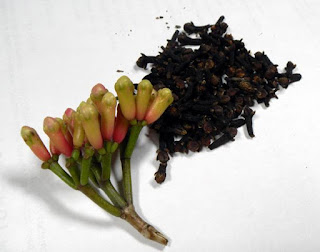from
Behind the French Menu
by
Bryan G. Newman
behindthefrenchmenu@gmail.com
Dill
(Dill weeds are dried dill leaves, and they certainly are not weeds.
The taste of dill.
I am not a great fan of
strong aniseed tastes; however, dill is not aniseed. Dill is mild,
and in marinades, soups, and sauces, it adds a light aniseed accent that I do
like. The French use the feathery dill leaves to marinate fresh salmon
and other fish dishes.
Dill seeds.
The seeds are 4–5 mm (0.16–0.20 in)
long and 1 mm (0.04 in) thick.
www.flickr.com/photos/44799719@N00/368305912/
Fresh dill leaves,
surprisingly, have a lighter taste than the same leaves in their dried
form. Dill leaves and their seeds, which
are their fruits, are available fresh or dried.
Dill leaves are milder than the seeds and more likely to be used on
their own in herbal butters, herbal vinegar, or flavor salads. Dill seeds are
used as a salt substitute, for pickling, and to flavor pastries.
Dill on French menus:
Barbecuing tiger prawns flavored with dill.
www.flickr.com/photos/avlxyz/10511535635/
Escalope de Veau Panée, Sauce Crémeuse à l’Aneth
et Citron
– A breaded veal scallop/escalope served with a cream sauce flavored
with dill and lemon.
Plaice
in a dill sauce, with peas and potato
pancakes.
www.flickr.com/photos/40132124@N00/10560573566/
Petites
Tartelettes au Thon,
Chèvre
Frais et Aneth – Small tuna
tarts, made with fresh goat’s
cheese flavored with dill.
Salade de Carpe Fumée
Maison, Crème Citronnée à l’Aneth et Œufs de Lumps - A salad of home-made smoked carp; served with a
lemon-flavored cream sauce with added dill and lumpfish eggs. N.B.: Lumpfish
eggs are called lumpfish caviar outside of France. In France, the only fish
eggs that may be called caviar are those
that come from the sturgeon.
Dill marinated salmon.
Saumon Mariné à l'Aneth – Salmon marinated in dill. When this dish is well-made and
thinly sliced, it is the only dish I know to compete with the best smoked
salmon for flavor and texture.
Dill and Fennel.
Dill’s green stalks, leaves, and seeds look like a smaller version
of fennel; that is not too surprising as they are members of the same
family. However, dill is the spice of
choice for recipes when a light aniseed touch is needed. Fresh dill keeps well in a refrigerator, but
when fresh dill is not available, unlike many other spices that lose flavor
when dried, dried dill is an acceptable alternative and is stronger than fresh
dill.
Dill’s origins.
Some herb and spice experts will tell you that dill originated in
Europe and others in Central Asia. In
Europe, we know the Ancient Romans and Greeks used dill in many recipes, and
from those two countries, you may see how the taste for dill progressed with
recipes, including dill spreading throughout the Mediterranean. In Asia, India has its own variety of dill
called Sowa.
Wherever dill originated, it was undoubtedly one of the Old-World
exports to the New World. In North America,
dill leaves are marketed as dill weeds; however, dill weeds are dried dill
leaves, and they certainly are not weeds.
The origin of dill’s English name.
The English name dill comes from the Scandinavia, where the words,
dill, dild, dila, are all words that indicate calm. French and other homeopathic doctors
prescribe dill to calm an upset stomach and other disorders.
Salad with cucumber, radish, and dill with yogurt sauce
www.flickr.com/photos/30478819@N08/48841116057/
Dill and aniseed.
Dill has two other French names, Faux Anis and Fenouil Bâtard, but
they will not usually be seen on menus. For those seeking real Aniseed in
France, it is called Anis and Anis Vert. Star Anise, the star-shaped fruit of the Chinese Aniseed
flavored spice, is called Anis Étoile and Badiane.
Not from France.
One of America's favorite pickles, the kosher dill cucumber.
www.flickr.com/photos/maggiemuddphotography/4347393210/
Dill in the languages of France’s neighbors:
(Catalan – anet), (German - dill,
gurkenkraut), (Italian – aneto), (Spanish - hinojo hediondo, abesón,
aneldo, eneldo).
Dill in other languages:
(Chinese (Mandarin) -歐洲蒔蘿 ōu
zhōu shì luó, 蒔蘿 shì luó), (Dutch – dille), (Greek –
Άνηθος, anithos)m (Hebrew- shevet rehanee, shamir, שבת ריחני, שמיר ), (Japanese
-ディル, イノンド, siru, inondo), (Korean -딜, 이논드, tir,
inondu), (Malay - adas china, adas pudus, ender), (Norwegian –
dill), (Polish - koper ogrodowy), (Portugues – endro,
aneto),(Rumanian - mărar), (Russian – Укроп, ukrop), (Ukranian -
kріп, kріп запашний, yкріп, kопер, krip, krip zapashnyj, ukrip, koper). With
thanks to Gernot Katzer and his spice pages for the many
translations and other assistance.
--------------------------------
Behind the French Menu
Behind the French Menu
by
Bryan G. Newman
behindthefrenchmenu@gmail.com
Copyright 2010, 2015, 2020.
--------------------------------
Searching for the meaning of words,
names or phrases
on
French menus?
Just add the word, words, or phrase that you are searching for to
the words "Behind the French Menu" (best when including the inverted
commas), and search with Google, Bing, or another browser. Behind
the French Menu’s links, include hundreds of words, names, and phrases that are
seen on French menus. There are over 450 articles that include over 4,000
French dishes with English translations and explanations.
Connected posts:
Fenouil - Fennel, the Herb, and the Vegetable. Fennel on French Menus.
For other herbs and spices from behind the
French Menus see:












